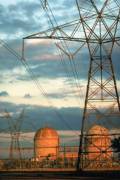Japanese Nuclear Emergency Response Support System
Background
The Japanese government wanted to be prepared to make decisions in case of nuclear plant accidents -- e.g., evacuating a city. NUPEC (“NUclear Power Engineering Corporation”) was a government-sponsored corporation that helped monitor nuclear plant safety, analogous to the American NRC. NUPEC had established a consortium with the 3 Japanese nuclear vendors (Mitsubishi, Hitachi, and Toshiba) to build an emergency response system. (NUPEC was incorporated into the new “Japan Nuclear Energy Safety Organization (JNES) in 2003. JNES and the “Nuclear and Industrial Safety Agency” (NISA), manage the regulation of nuclear power in Japan.)
Business Problem
 The government wanted a technology and a solution for monitoring plant data remotely at multiple offsite centers, and analyzing the results to make better decisions, developed in conjunction with the 3 Japanese nuclear vendors. This would allow them to make judgments independently, without having to rely completely on the plant operators such as TEPCO. A second goal was to obtain the best available American AI (Artificial Intelligence) technology for solving these kinds of problems, providing a mechanism for R&D and technology transfer to the 3 vendors. A related goal was to build a system better than the American NRC-sponsored RSAS system. The government wanted a technology and a solution for monitoring plant data remotely at multiple offsite centers, and analyzing the results to make better decisions, developed in conjunction with the 3 Japanese nuclear vendors. This would allow them to make judgments independently, without having to rely completely on the plant operators such as TEPCO. A second goal was to obtain the best available American AI (Artificial Intelligence) technology for solving these kinds of problems, providing a mechanism for R&D and technology transfer to the 3 vendors. A related goal was to build a system better than the American NRC-sponsored RSAS system.
Solution
 R&D and training sessions were run to achieve the technology transfer goals. Software prototypes were built exploring a wide range of technologies, including case-based reasoning extended for real-time use, logic diagrams, signed digraphs, and Bayesian methods. (These methods are described in the Guide to Fault Detection and Diagnosis.) We ended up emphasizing graphical-language solutions, as the engineers tended to think in terms of logic diagrams, and very detailed fault trees were already available as part of risk analysis documentation. It was simpler for the engineers to enter the diagrams directly on the screen in graphical format than to try to translate them into some text-based form. Although the implementation has changed from the original G2-based solution, the form of the logic diagrams in the current system are still essentially the same, as seen in this current ERSS screen image. R&D and training sessions were run to achieve the technology transfer goals. Software prototypes were built exploring a wide range of technologies, including case-based reasoning extended for real-time use, logic diagrams, signed digraphs, and Bayesian methods. (These methods are described in the Guide to Fault Detection and Diagnosis.) We ended up emphasizing graphical-language solutions, as the engineers tended to think in terms of logic diagrams, and very detailed fault trees were already available as part of risk analysis documentation. It was simpler for the engineers to enter the diagrams directly on the screen in graphical format than to try to translate them into some text-based form. Although the implementation has changed from the original G2-based solution, the form of the logic diagrams in the current system are still essentially the same, as seen in this current ERSS screen image.
|